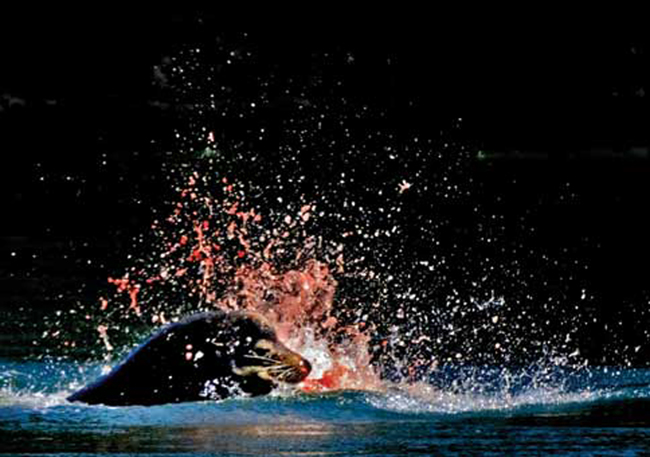forum
library
tutorial
contact

Humane Society and Fish Wild Conservancy
File Suit to Stop Illegal Sea Lion
by Ted Williams
Fly Rod and Reel, March 19, 2012
|
the film forum library tutorial contact |

|
Humane Society and Fish Wild Conservancy
by Ted Williams
|
Limits Take to 30, With No Shooting Allowed
 WASHINGTON (March 19, 2012) -- The Humane Society of the United States, Wild Fish Conservancy and two individual plaintiffs filed suit in federal court, seeking to stop the National Marine Fisheries Service from once again authorizing Idaho, Washington and Oregon to kill sea lions at Bonneville Dam--as many as 460--over the next five years.
WASHINGTON (March 19, 2012) -- The Humane Society of the United States, Wild Fish Conservancy and two individual plaintiffs filed suit in federal court, seeking to stop the National Marine Fisheries Service from once again authorizing Idaho, Washington and Oregon to kill sea lions at Bonneville Dam--as many as 460--over the next five years.
In November 2010, the Court of Appeals for the Ninth Circuit overturned a prior attempt by the agency to authorize the killing of sea lions, finding that NMFS had not properly justified its decision and that salmon populations are at greater risk from overfishing and dam operations than they are from native sea lion predation. In 2010, when the sea lions consumed less than 2 percent of the salmon run, fisheries harvested 17 percent of these same fish. In 2011, sea lions consumed just over 1 percent of the salmon run at the same time that Oregon and Washington permitted fisheries in the Columbia River to harvest as much as 12 percent of the very same run.
"Federal law allows the killing of sea lions only in very limited circumstances, when the agency proves they are having a significant negative impact on salmon," said Jonathan R. Lovvorn, senior vice president and chief counsel for animal protection litigation for The HSUS. "The National Marine Fisheries Service's decision to kill hundreds of native marine mammals to reduce salmon losses by a couple of percentage points at best, while simultaneously authorizing much larger man-made sources of endangered salmon mortality, is both outrageous and patently illegal."
While blaming sea lions for eating salmon, the states and NMFS have largely ignored major impediments that impede salmon recovery, including recommendations of government scientists to stop stocking non-native fish like bass and walleye for the purpose of recreational fishing, because these fish compete with and eat native salmon. Experts have warned that curbing the impact of these non-native fish is imperative for salmon recovery.
"NMFS continues to play a shell game with harvest numbers," said Kurt Beardslee, executive director of Wild Fish Conservancy. "They refuse to honestly and scientifically consider the effects of harvest. More endangered wild salmon would return to spawn if NMFS would require selective harvest in all fisheries and require fishers to release wild fish. This could be done without reducing the overall harvest rates, without killing a single sea lion, and it could be done with a stroke of a pen."
FACTS:
While birds, other fish (including non-native fish stocked by the states for the benefit of sport fishermen) and sea lions all kill salmon, the primary threats to salmon recovery are from loss of quality habitat and dams blocking their normal migratory routes up and down river. These impediments are compounded by harvest practices and hatchery operations that independent expert panels have highlighted as badly in need of reform.
The plan to shoot sea lions coincides with estimates that this spring's Columbia River salmon run is likely to be the among the fourth largest since 1980 while, as of the date of lethal removal authorization, only two California sea lions had been seen at the dam, the fewest to date of any year since 2003 and the time each animal spends at the dam has been steadily declining over the past few years.
The major causes of salmon losses are:
- Dams: NMFS estimates the Federal Columbia River Power System kills 16.8 percent of adult Snake River Basin Steelhead and 59.9 percent of juveniles.
- Hatcheries: In 2009, a Congressionally-mandated science panel found that current fish hatchery practices interfere with recovery and are in urgent need of reform.
- Fishing: The states annually authorize the incidental take of between 5.5 and 17 percent of the Upper Columbia spring Chinook and Upper Snake River spring/summer Chinook. Additional salmon are killed in ocean fisheries. Employment of selective gear would permit wild, ESA-listed salmon and steelhead to be released unharmed when caught in the Columbia River fisheries that target abundant hatchery fish.
- Other Predators: Bird predators consume millions of juvenile salmon in the Columbia River estuary each year. NMFS scientists also estimate that non-native walleye that are intentionally stocked by the states in the Columbia River eat up to 2 million juvenile salmon a year.
learn more on topics covered in the film
see the video
read the script
learn the songs
discussion forum
